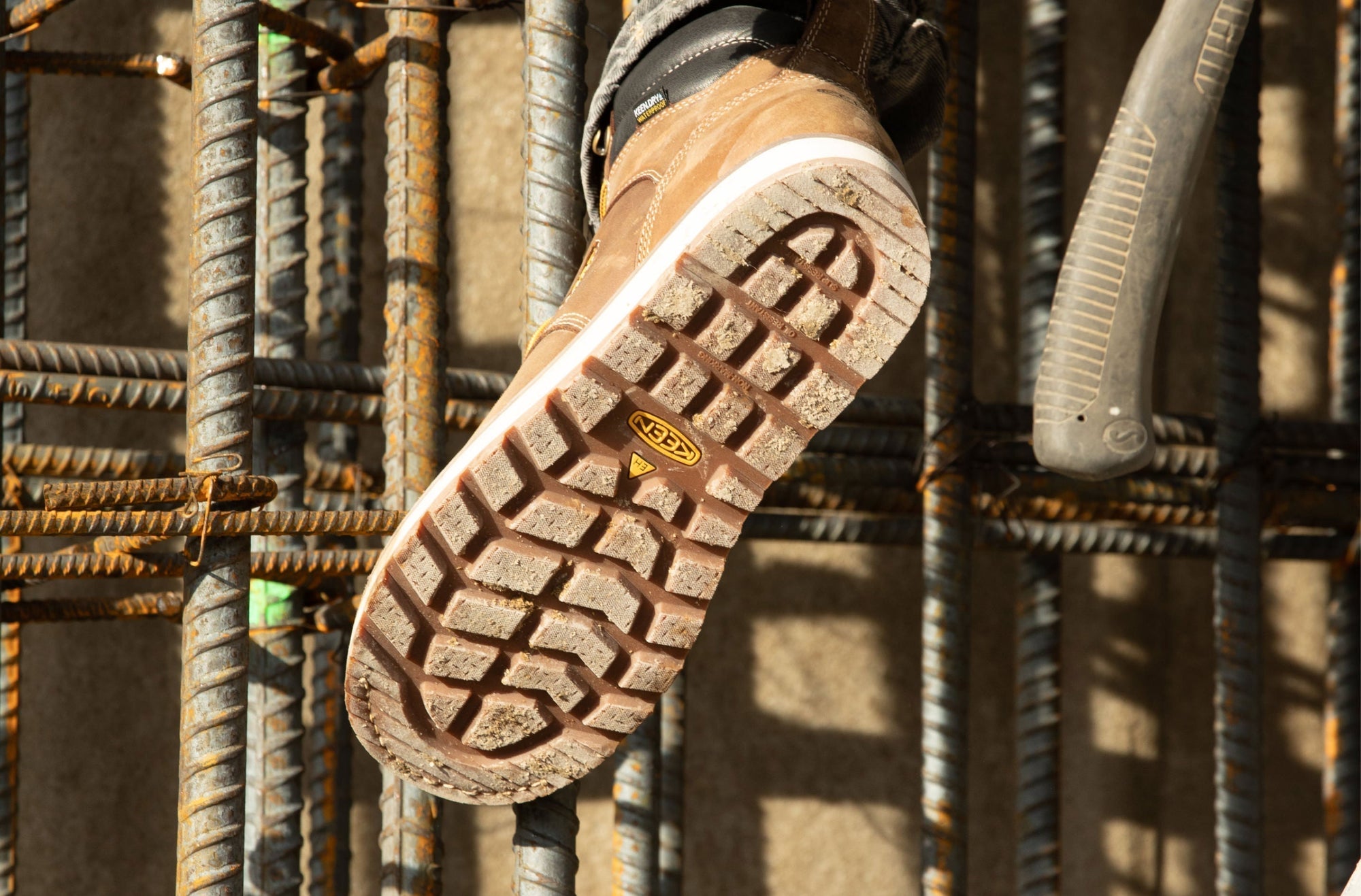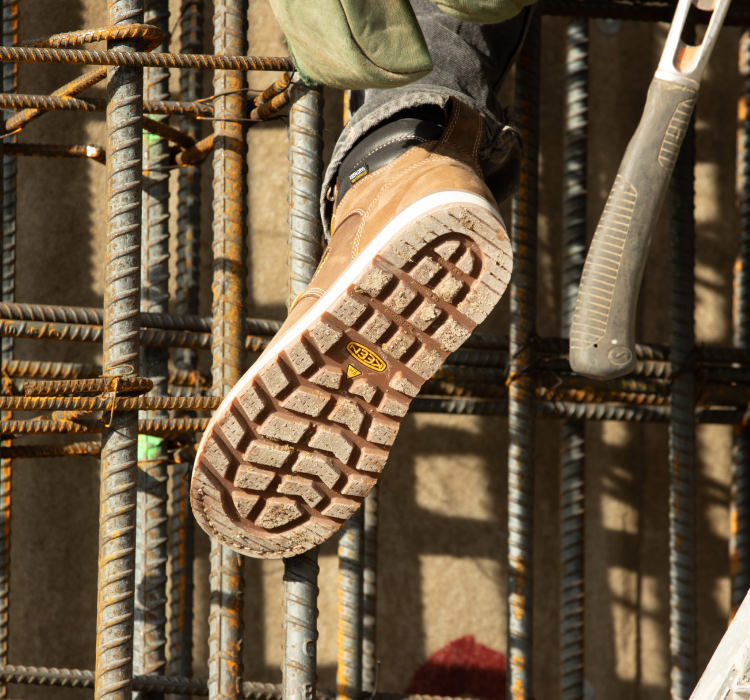Work footwear protects your feet in many different ways.
Leather uppers shield against scrapes, slip-resistant outsoles keep you surefooted, and waterproof technologies keep you dry on the wettest jobsites. One of the most important things they do, though, is protect your toes. KEEN Utility offers five toe types – four safety and one soft. Let’s find out which one works best for your workload.
Soft, aluminum, composite, carbon, and steel. This isn’t an ingredient list for building a motorcycle. Rather, these are the different types of toe caps offered in KEEN Utility products. Why so many options? Well, like any other gear you might consider buying, the toe type you choose depends on things like cost, features, and weight. In this article, we’ll take a deep dive into the world of work footwear toes.
How Do Safety Toes Keep Feet Safe?
Just like a hard hat protects your head from bumps and dropped objects, safety toe caps protect the front of your feet. They’re an important part of a PPE kit at work, alongside safety glasses, a reflective vest, and gloves.
Previous generations of workers usually had only one safety toe option. Steel. We still do offer steel toes, but we’ve also worked hard to introduce lighter-weight, more innovative toe types as well. So, in addition to steel toes, you’ll find aluminum, composite, and carbon toes.
Do All KEEN Utility Safety Toes Protect the Same?
All of our products that contain a safety toe must meet the same standard: specifically, ASTM F2413-18 M I/75 C/75 EH. The I/75 C/75 rating indicates that the safety toe has an impact resistance of 75 foot-pounds and a compressive load resistance of up to 2,500 pounds. We test all of our safety toes to ensure they meet this standard and provide the same level of protection. For more information about this and other industry-standard safety ratings that our products must adhere to, read this article.
Soft Toes

Not all jobs require a safety toe. If your day involves lighter-duty tasks like carpentry, light framing, truck driving, DIY projects, or office-to-site hybrid work, soft-toe work shoes might be a great fit. Our soft toe styles look just like their safety toe counterparts but don’t provide a secondary source of crush or impact resistance.
Benefits of Soft Toes
• No Additional Weight: No structural safety toe = no added weight.
• Flexible: Much like your favorite pair of sneakers or hiking boots, soft-toe styles flex evenly across the whole forefoot.
• Versatile: Styles like the San Jose Soft Toe for men and women are fit for your whole day. Get the same great easy-wearing comfort, from jobsite to campsite and everywhere in between.
Drawbacks of Soft Toes
• Limited Protection: Our soft toe boots offer abrasion resistance and will guard against minor impacts. However, we recommend choosing a boot with a structural safety toe if you work around heavy or compressive things.
Aluminum Safety Toes

Aluminum is extremely popular in the aircraft industry because it’s very lightweight and also super strong. So it made sense to use it in safety toe boots where weight savings are paramount. Find aluminum toes in our popular San Jose work boots and Sparta 2 work sneakers.
Benefits of Aluminum Safety Toes
• Lightest Weight: About 30% lighter than steel while offering the same protection.
• Corrosion-Resistant: Unlike steel, aluminum won’t rust. This is important if you spend lots of time working where it’s wet.
Drawbacks of Aluminum Safety Toes
• Conductive: Aluminum toes will conduct electricity and temperature, similar to steel toes.
• Metallic: Aluminum toes will set off metal detectors, even if used in footwear that’s otherwise metal-free.
Composite Safety Toes

Composite safety toes have largely been replaced by carbon safety toes in the KEEN Utility work footwear lineup, but can still be found in the Davenport.
Benefits of Composite Safety Toes
• Lightweight: About 10% lighter than steel while offering the same protection
• Non-Metallic Construction: When used in metal-free footwear, composite toes make it easier to pass through metal detectors.
• Non-Conductive: Composite toes won’t conduct electricity or temperature.
Drawbacks of Composite Safety Toes
• Bulky: Compared to aluminum, carbon, or steel toes, composite toes are thicker and more bulbous.
Carbon Safety Toes

Formula One racecars. F-22 fighter jets. Tour De France bikes. What do these have in common? Answer: Lots of carbon for structure and safety. While we like to think our carbon safety toes are as exciting as a racecar, the underlying benefits provided by this material are one and the same. Our most popular safety toe type, you’ll find it on many of our newest boots and shoes, like the Kenton, Speedworks, and Evanston.
Benefits of Carbon Safety Toes
• Lighter Weight: About 15% lighter than steel while offering the same protection.
• Non-Metallic Construction: When used in metal-free footwear, carbon toes make it easier to pass through metal detectors.
• Non-Conductive: Carbon toes won’t conduct electricity or temperature.
Drawback of Carbon Safety Toes
• Cost: Carbon, as an advanced material, is slightly more expensive to use in work footwear.
Steel Safety Toes

Steel safety toes have been a mainstay on jobsites for almost one hundred years. So, there’s a high chance that your parents wore steel-toe safety shoes. And your grandparents, too, probably. As our second most popular safety toe type, steel toes still serve an important purpose.
Benefits of Steel Safety Toes
• Proven Protection: It’s easy to trust a technology that’s been jobsite-proven over and over again for almost a century.
• Cost-Effective: Steel toes are used in some of our least expensive safety toe shoes. They’re a great choice if you’re trying to balance cost and value.
Drawbacks of Steel Safety Toes
• Weight: This is a big one. Steel safety toes are the heaviest option. We work hard to sculpt ours efficiently and to use the minimum quantity of material required while still maintaining safety. But, steel is still steel.
• Conductive: Steel toes will conduct electricity and temperature. So, a carbon toe might be a better option if you often work in extreme environments.
• Metallic: Even if used in footwear that’s otherwise metal-free, steel toes will still set off metal detectors. This makes it more difficult to get into/out of secured areas, as you’ll have to remove your steel toe shoes more often.
KEEN has been protecting toes since 2003 with our KEEN.PROTECT toe bumper on sandals and hikers. And now with five different KEEN Utility toe types, you've got all your toes covered on the job, too.














